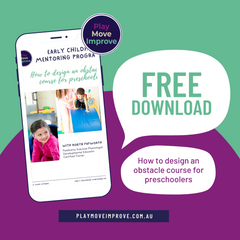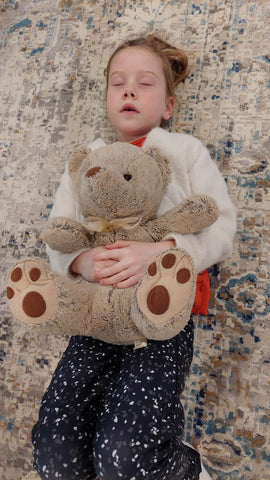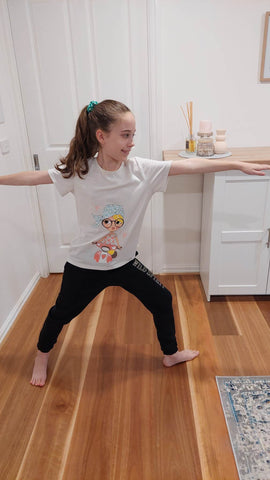Why is it important for children to learn the speed and force of their movement for self-regulation
Learning about the speed and force of their movement is important for children because it helps them develop self-regulation skills.
Being able to control the speed (slow, fast) and force (gentle, rough) of our movement is important in early childhood, because when children are more connected with their body and mind they have improved skills in these areas:
Safety:
Understanding the speed and force of their movements allows children to navigate their environment safely. They can learn to control their actions and avoid situations that may result in injury to themselves or others. For example, they can learn to walk carefully on slippery surfaces or control their swinging movements on a playground.
Activity: "Obstacle Course Challenge" Description: Set up a simple obstacle course in a safe and supervised area. Include tasks that require children to control their movements, such as walking carefully on a balance beam, crawling under a low tunnel, or stepping over obstacles. Encourage them to navigate the course while being mindful of their speed and force to avoid tripping or falling.
Emotional regulation:
Awareness of their movement speed and force can help children manage their emotions and impulses. By recognising how their movements impact their own bodies and the world around them, they can learn to modulate their actions accordingly. This can be particularly beneficial when they feel overwhelmed or frustrated, as they can adjust their movement to promote calmness and reduce stress.
Activity: "Breathing Buddies" Description: Have children lie down with a stuffed animal on their belly. Instruct them to take slow, deep breaths, watching how their "Breathing Buddy" rises and falls with each breath. Explain that this activity helps them calm down when they're feeling upset or stressed. Encourage them to match their breathing to their Buddy's movements, promoting self-awareness and emotional regulation.
Social interactions:
Understanding the speed and force of their movements is crucial for children when interacting with others. It enables them to develop appropriate social skills, such as taking turns, sharing, and respecting personal space. By learning to regulate their movements, they can avoid inadvertently harming others or causing discomfort, fostering positive relationships with peers and adults.
Activity: "Mirror Movements" Description: Pair children up or do this in a large group with you being the leader. For pairs, one child is the "leader," and the other is the "mirror." The leader performs slow, deliberate movements, and the mirror partner must mimic these actions exactly. This activity helps children understand how their movements affect others and promotes the concept of respecting personal space and mirroring social cues.
Focus and attention:
By developing an awareness of their movement, children can enhance their focus and attention span. They can learn to control their bodies and movements, which in turn improves their ability to concentrate on tasks and follow instructions. This skill is particularly valuable in educational settings, where children need to sit still, listen attentively, and complete activities requiring fine motor skills.
Activity: "Yoga Storytime" Description: Incorporate a short yoga session into storytime. Choose a children's book with a simple narrative that includes animals or nature. As you read the story, pause at certain points and guide the children through corresponding yoga poses, such as "Tree Pose", "Warrior Pose", or "Butterfly Pose." This activity combines storytelling and controlled movement, enhancing their focus and attention.
Body awareness and coordination:
Understanding the speed and force of their movements helps children develop body awareness and coordination. They become more conscious of how their bodies move through space and can refine their motor skills accordingly. This improved coordination is essential for various physical activities, such as sports, dancing, and playing musical instruments.
Activity: "Pillow Stepping Stones" is an engaging activity that enhances children's body awareness, balance, and coordination. Set up pillows or cushions in a scattered pattern on the floor and ask children to step from one to the next. Encourage slow, deliberate movements to ensure balance and control. You can add challenges like stepping on specific colors or patterns or timing their progress, making it a fun and educational exercise.
Impulse control:
Self-regulation involves managing impulsive urges and delaying gratification. When we learn to control the speed and force of our movements, we develop the ability to pause, reflect, and make intentional choices rather than acting on immediate impulses. This control extends beyond physical movements to encompass our thoughts and behaviors, allowing us to make more thoughtful decisions.
Activity: "Red Light, Green Light" Description: Play the classic game "Red Light, Green Light." Children line up at a starting point, and one child plays the role of the "stoplight." When the stoplight calls "Green Light," the other children move forward. When they call "Red Light," everyone must stop immediately. This game teaches impulse control as children must quickly stop their movements when instructed, reinforcing the concept of intentional choices.
There is also a seated version, where you use the same red and green visuals, but pass around a bean bag or ball to practice impulse control in an indoor group mat time environment.
To quickly teach children self-regulation through movement, I like to use animal cards as part of children's daily routine so they can feel the difference in their movement, posture, and force when pretending to move like a sloth, versus an elephant, versus as mouse.








Thanks Louise :) I’ll send you an email about coming to the Mallee region :) Here is the YouTube video where I explain more about the following instructions activity that you’re mentioning – https://youtu.be/5×7pVVI4EDE
Hi Robyn, I saw a resource on your fb page recently about self regulation, it had ideas around sequencing actions, following instructions according to a particular colour ball etc. Unfortunately I didn’t have time to look at it properly and now I can’t see where it is either in your posts or on your website. I hope you can share it again, please. Also, do you ever come up into the Mallee for professional development visits? Thankyou. Louise, from Ouyen Preschool.
Leave a comment